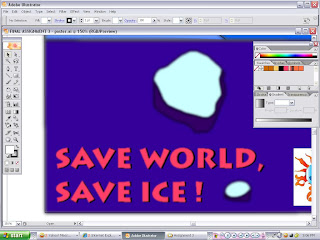 my sketch for the poster.
my sketch for the poster.
after got my overall idea, now i can start with tracing my sketches. i use pen tools to trace up the sketches. started with the first picture, the world still have ice save for the animals.

after finish the first sketch on the first picture, lets do the second picture, still using the pen tool. for the 2nd picture is about the world have lost the ice.
 it is time to play with colors. for the ice i add blueish and the orange is for the sky. i use gradient tool to mixed up the color. and i use some blur effect.
it is time to play with colors. for the ice i add blueish and the orange is for the sky. i use gradient tool to mixed up the color. and i use some blur effect.
same goes to the ice and the ocean, by using gradient and blur tool. finish my first picture. lets start the 2nd picture..
same as the 1st picture, i still use gradient tool to mixed up colors and blur tool. next step, think for the caption!.

slogan : SAVE WORLD, SAVE ICE. means, if you want to save the world for not covered up 100% with water, then you must save the ice first before its melting so that the level of water will not increased.
my poster..! =)

































